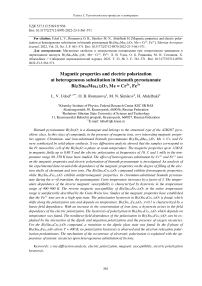Magnetic properties and electric polar-ization at heterogeneous substitution in bismuth pyrostannate Bi2(Sn0.9Ме0.1)2O7, Ме = Cr3+, Fe3+
Автор: Udod L.V., Romanova O.B., Sitnikov M.N., Abdelbaki H.
Журнал: Siberian Aerospace Journal @vestnik-sibsau-en
Рубрика: Technological processes and material science
Статья в выпуске: 3 vol.23, 2022 года.
Бесплатный доступ
Bismuth pyrostannate Bi2Sn2O7 is a diamagnet and belongs to the structural type of the A2B2O7 pyro-chlore class. In this class of compounds, in the presence of magnetic ions, very interesting magnetic proper-ties appear. Chromium- and iron-substituted bismuth pyrostannates Bi2(Sn0.9Me0.1)2O7, Me = Cr, and Fe were synthesized by solid-phase synthesis. X-ray diffraction analysis showed that the samples correspond to the Pc monoclinic cell of the Bi2Sn2O7 α-phase at room temperature. The magnetic properties up to 1100 K in magnetic fields up to 0.86 T and the electric polarization at frequencies of 10, 3, and 1 mHz in the tem-perature range 80–550 K have been studied. The effect of heterogeneous substitution by Cr3+ and Fe3+ ions on the magnetic properties and electric polarization of bismuth pyrostannate is investigated. An analysis of the experimental data revealed the dependence of the magnetic properties on the degree of filling of the elec-tron shells of chromium and iron ions. The Bi2(Sn0.9Cr0.1)2O7 compound exhibits ferromagnetic properties, while Bi2(Sn0.9Fe0.1)2O7 exhibits antiferromagnetic properties. In chromium-substituted bismuth pyrostan-nate during the α→β transition, the paramagnetic Curie temperature increases by a factor of 3. The temper-ature dependence of the inverse magnetic susceptibility is characterized by hysteresis in the temperature range of 400–900 K. The reverse magnetic susceptibility of Bi2(Sn0.9Fe0.1)2O7 in the entire temperature range is satisfactorily described by the Curie-Weiss law. Studies of the magnetic properties have established that the Fe3+ ions are in a high-spin state. The polarization hysteresis in Bi2(Sn0.9Cr0.1)2O7 is found, which shifts along the polarization axis and depends on temperature. Bi2(Sn1-xFex)2O7, x=0.1 is characterized by a linear field dependence. With an increase in the concentration of iron ions, a hysteresis arises in the field dependence of the electric polarization. The hysteresis of polarization in Bi2(Sn0.9Cr0.1)2O7 which depends on temperature was found. The nonlinear field dependence of the polarization in Bi2(Sn0.8Fe0.2)2O7 can be ex-plained by the interaction of the dipole and migration polarizations and the presence of oxygen vacancies. For the Bi2(Sn0.9Cr0.1)2O7 compound, a transition to the dipole glass state was found. In the β-phase of Bi2(Sn0.8Fe0.2)2O7 above T = 400 K, no polarization hysteresis is observed and the electron-relaxation polar-ization predominates. The mechanism of the occurrence of electronic polarization is explained with the ap-pearance of anionic vacancies upon heterogeneous substitution of tin ions.
X-ray diffraction analysis, electric polarization, magnetic susceptibility, electric polarization hysteresis
Короткий адрес: https://sciup.org/148329651
IDR: 148329651 | УДК: 537.312:538.911'956 | DOI: 10.31772/2712-8970-2022-23-3-561-571
Текст научной статьи Magnetic properties and electric polar-ization at heterogeneous substitution in bismuth pyrostannate Bi2(Sn0.9Ме0.1)2O7, Ме = Cr3+, Fe3+
Materials used in modern electronic devices must have ferroelectric, ferromagnetic or antiferromagnetic properties at the same time. Such materials include complex oxides containing iron ions. They manifest the magnetoelectric effect and the properties of multiferroics [ 1-5 ] . Magnetoresistive
* The research was funded by RFBR, Krasnoyarsk Territory and Krasnoyarsk Regional Fund of Science, project number 20-42-243002.
Работа выполнена при финансовой поддержке РФФИ, Красноярского края и Красноярского краевого фонда науки, проект № 20-42-243002.
effects resulting from the interaction of the magnetic subsystem with the spins of conduction electrons were studied in the framework of the s-d model and the model of the interaction of orbital magnetic moments with spin ones based on manganese sulfides. Magnetoresistance can be caused by spin-orbit interaction in topological insulators [ 6-11 ] .
The combination of magnetic and electrical properties characteristic of multiferroics is shown by compounds based on the structural type of pyrochlore A2B2O7. These materials are characterized by both spontaneous magnetization, magnetostriction, spontaneous polarization and piezoelectric effect, and magnetoelectric effect (magnetic field-induced electric polarization and electric field-induced magnetization), as well as the effect of magnetoelectric control (switching of spontaneous polarization by magnetic field and spontaneous magnetization by electric field). Magnetoelectric effects can be caused both by magnetoelastic interaction [12] and as a result of the Maxwell–Wagner effect [13-14]. Cations A and B in the structure of pyrochlore A2B2O7 form a sublattice of tetrahedra connected by angles, which can lead to intense frustration of the magnetic interaction and low-temperature properties [ 15 ] . In Cd 2 Ti 2 O 7 , strong frustrations lead to a disordered state of spins below the Curie-Weiss temperature T CW ≈ 10 K. Frustrated exchange interactions can lead to a decrease in magnetization [16-17] and to the formation of spin glass [18-19]. The transition to the ordered phase is due to the dipole-dipole interaction at T ~ 1 to [ 20 ] . The absence of complete ordering is accompanied by the complete destruction of the long-range order and the formation of a paramagnetic state of the spin liquid type [21-26]. This causes a magnetocaloric effect, which is in demand in cryotechnics.
The cationic environment in the crystal structure of pyrochlores makes antiferromagnetic interaction between cations of uniaxial directions impossible [ 27 ] . Apparently, for this reason, many pyrochlores are characterized by the absence of a long-range magnetic order. As a rule, complex oxides with a pyrochlore structure exhibit a spin-glass state. However, such compounds can also be ferromagnetic, for example
Ln 2 V 2 O 7 (Ln = Lu, Yb, Tm) [ 28 ] . Manganese-containing pyrochlores reveal a complex dependence of the magnetic characteristics on the nature of the A-cation. So, if Sc, Y, Lu are in the A-position, then the compounds are characterized by spin-glass behavior and exhibit semiconductor properties [ 29 ] , and Tl 2 Mn 2 O 7 and In 2 Mn 2 O 7 are ferromagnets [ 30 ] . Bismuth pyrostannate Bi 2 (Sn 1–х Mn х ) 2 O 7 , x = 0.05 and 0.1, exhibits antiferromagnetic properties. With an increase in the concentration of M n 4+, an increase in antiferromagnetic exchange is observed.
There are no magnetic ions in the crystal structure of bismuth pyro-stannate Bi 2 Sn 2 O 7 . By replacing Sn 4+ ions with 3d elements, new compounds related to multiferroics can be obtained. Isovalent substitution with M n 4+ ions led to antiferromagnetism. During heterovalent substitution with Cr 3+ and Fe3+ions, distortions ofoxygen octahedra will be observed, which will lead to spontaneous polarization and magnetic order. The different degree of filling of the electron shells of ions (Cr3+1s22s22p63s23p64s03d3 and Fe3+1s22s22p63s23p64s23d3) will affect the magnetic and electrical properties.
The aim of the work is to establish the effect of heterogeneous substitution by Cr 3+ and Fe 3+ ions on the occurrence of magnetic order and polarization in bismuth Bi 2 Sn 2 O 7 pyrostannate.
Experimental methodology
The synthesis of bismuth pyro-stannate substituted by 3d elements Bi 2 (Sn 0.9 Me 0.1 ) 2 O 7 , Me = Cr and Fe was performed by the method of multi-stage solid-phase synthesis. X-ray structural data indicate that the synthesized samples correspond to a monoclinic Pc cell in the α-phase Bi 2 Sn 2 O 7 at room temperature [31-35]. The crystal structure of Bi 2 Sn 2 O 7 contains 32 Bi3+ ions, 32 Sn4+ ions and 112 O2 ions in the independent part of the cell (Fig. 1). All Bi3+ ions have eight O2-ions in their immediate surroundings and form distorted cubes, and Sn 4+ are surrounded by six O 2-ions and form octahedra that are connected by vertices. Replacing the Sn4+ ions, the Cr3+ and Fe3+ ions create defects in the oxygen octahedron SpO 6 (insert in Fig. 1).
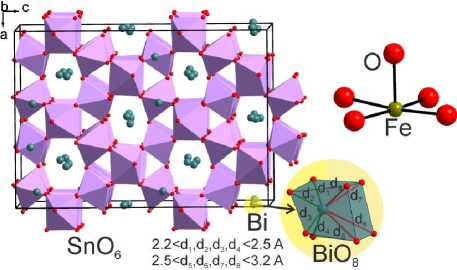
Fig. 1. Crystal structure of Bi 2 Sn 2 O 7 . The defect oxygen octahedron SnO 6 substituted by Fe3+ ions and the polyhedron BiO 8 are shown separately
Рис. 1. Кристаллическая структура Bi 2 Sn 2 O 7 . Отдельно показаны дефектный кислородный октаэдр SnO 6 с замещением ионами Fe3+ и полиэдр BiO8
The magnetic properties of Bi2(Sn0,9Ме0,1)2O7, Ме = Cr and Fe were studied on a high-temperature installation by the Faraday method in the temperature range up to 1100 K and magnetic fields up to 0.86 T. The field dependences of electric polarization were investigated by the quasi-static method at frequencies of 10.3 and 1 MHz in the temperature range of 80-550 K. Two cycles of measurements were carried out on samples on which silver contacts were applied, there is a varnish between the contacts and the sample to prevent leakage currents.
1. Magnetic susceptibility
The temperature dependence of the magnetic susceptibility for Bi 2 (Sn 0.9 Cr 0.1 ) 2 O 7 is shown in Fig.
-
2, a . The magnitude of the inverse magnetic susceptibility changes the slope (insert Fig. 2, a ) during the transition from the α→β phase at T = 370 K. The paramagnetic Curie temperature increases by 3 times. So, for the α-phase θ α = 50 K in the range 150 < T < 300 K, and the β-phase θ β = 150 K at T > 400 K. The temperature dependence 1/χ is characterized by hysteresis in the temperature range of 400-900 K, corresponding to the boundaries of the existence of the β-phase.
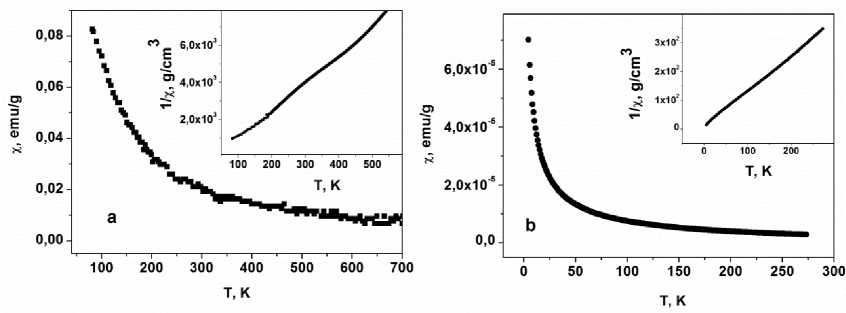
Fig. 2. The temperature dependence of the magnetic susceptibility of Bi 2 (Sn 0,9 Me 0,1 ) 2 O 7 :
a – Me = Cr; b – Me = Fe. The insets show the temperature dependences of the reciprocal susceptibilities
Fig. 2. Температурная зависимость магнитной восприимчивости Bi 2 (Sn 0,9 Ме 0,1 ) 2 O 7 : a – Me = Cr; б – Me = Fe. На вставках приведены температурные зависимости обратной восприимчивости
Magnetic susceptibility in a magnetic field of 600th for Bi2(Sn0.9Fe0.1)2O7 exhibits paramagnetic character and is shown in Fig. 2, b. The insert (Fig. 2, b) shows the temperature dependence of the in- verse magnetic susceptibility, which is satisfactorily described in the entire temperature range by the Curie–Weiss law 1/χ = (T – θ) / C, where χis the magnetic susceptibility, θ– paramagnetic Curie temperature, C is the Curie constant. The value of the paramagnetic temperature has a negative value Θ = -10 K. Using the formula
μ eff = (8C / n)1/2, (1)
the effective magnetic moment Fe3+ was determined. Here C is the Curie constant; C=3kBNAg.B2N A is the Avogadro constant; n is the number of iron ions in Bi 2(Sn 0.9 Fe 0.1)2 O 7. The effective magnetic moment Fe3+ is calculated by equation (1) and is equal to µ eff = 5.76µ B. In bismuth pyrostannate, Fe3+ ions are in a high-spin state [35]. According to the equation gS=gS(S+1)gB^S = g(S(S + Hub)1 2, (2)
where S is the spin Fe3+ = 5/2; g – factor = 2, the theoretical value of the effective magnetic moment µ S = 5.92µ B. Using the obtained experimental data of magnetic characteristics, the g–factor for Bi 2 (Sn 0,9 Fe 0,1 ) 2 O 7 , g = 1.95 is calculated by formula (2).
Experimental data show a different effect of substitution ions on the magnetic exchange interaction of Bi 2 Sn 2 O 7 . The compound Bi 2 (Sn 0,9 Cr 0,1 ) 2 O 7 exhibits ferromagnetic properties, and Bi 2 (Sn 0,9 Fe 0,1 ) 2 O 7 exhibits antiferromagnetic properties. This difference is due to the different degree of filling of the electronic shells, for Cr3+ 4s0, а Fe3+ 4s2.
2. Polarization
The electric polarization Bi 2 (Sn 0,9 Cr 0,1 ) 2 O 7 increases linearly in an external electric field, a hysteresis of a small magnitude in the α phase is observed. When cycling, the hysteresis width increases linearly with the number of cycles. The field dependences of the polarization Bi 2 (Sn 0,9 Cr 0,1 ) 2 O 7 for temperatures above 400 K are shown in Fig. 3, b . The dielectric susceptibility χ = P/ε 0 E, determined in an electric field of 800 V/cm, increases when heated in α -phase and detects a maximum in the region of the transition temperature in the state of the dipole glass (Fig. 3, a ). Dipole glasses are characterized by a wide maximum of susceptibility in the region of "freezing" of dipole moments and irreversible behavior of susceptibility during heating and cooling in an electric field.
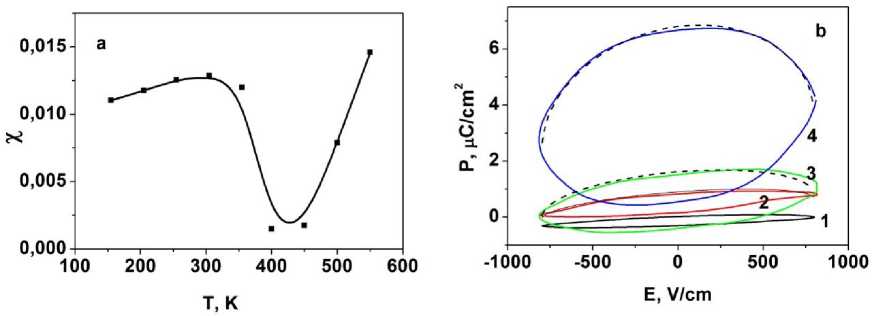
Fig. 3. Temperature dependence of the dielectric susceptibility of Bi 2 (Sn 0.9 Cr 0.1 ) 2 O 7 ( a ).
The field dependence of the polarization of Bi 2 (Sn 0.9 Cr 0.1 ) 2 O 7 ( b ). Curve 1 corresponds to T = 400 K with silver contacts, 2 – T = 400 K, 3 – T = 450 K, 4 – T = 500 K. 2 , 3 , 4 – varnish contacts
Рис. 3. Температурная зависимость диэлектрической восприимчивости Bi 2 (Sn 0,9 Cr 0,1 ) 2 O 7 ( а ); полевая зависимость поляризации Bi 2 (Sn 0,9 Cr 0,1 ) 2 O 7 ( б ). Кривая 1 соответствует Т = 400 К с серебряными контактами, 2 – Т = 400 К, 3 – Т = 450 К, 4 – Т = 500 К. 2 , 3 , 4 – лаковые контакты
The compound Bi2(Sn1–хFeх)2O7 (x = 0.1) exhibits paraelectric properties, the polarization is linear up to T = 300 K and corresponds to the law P = ε 0 χE, where ε 0 is the permittivity; χ is the susceptibility; E is the electric field. With an increase in the concentration of iron ions, x = 0.2, bismuth pyrostannate shows symmetrical hysteresis loops in an external electric field.
Figure 4 shows the field dependences of polarization at different temperatures in a magnetic field of 12 kOe for Bi 2 (Sn 1–х Fe х ) 2 O 7 , x = 0.2. The box (Fig. 4) shows the field dependence of polarization in the magnetic field H = 0 and 12 kOe at T = 160 K. Above room temperature, the electric polarization increases as a result of the appearance of an additional contribution in the form of migratory electronic polarization.
Delocalization of holes in the α-phase in the vicinity of replacement ions leads to diffusion and accumulation of charge in traps at intercrystalline domain boundaries. Under the influence of an external electric field, current carriers diffuse to the domain surface and are localized in traps. As a result, the intercrystalline boundaries become charged, which leads to polarization hysteresis and an increase in the width of the hysteresis loop. The formation of charged boundaries and partial shielding leads to an uneven distribution of potential over the sample volume. As a result of the restructuring of the crystal structure, the density of defects changes, for example, the concentration of oxygen vacancies decreases [37; 38] and a volume charge is induced in the sample.
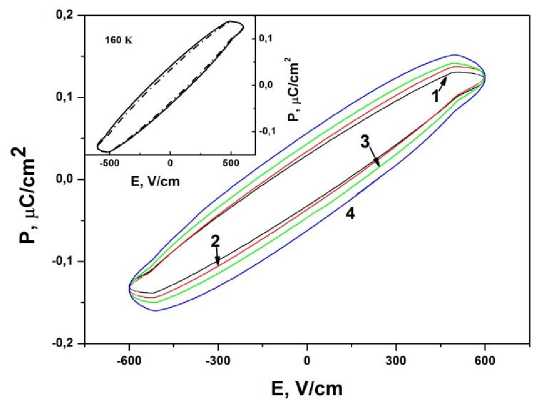
Fig. 4. Field dependence of the polarization of Bi 2 (Sn 0.8 Fe 0.2 ) 2 O 7 in a magnetic field H = 12 kOe at different temperatures. Curve 1 corresponds to Т = 120 K, 2 – 160 K, 3 – 200 K, 4 – 280 K. The inset shows the field dependence of the polarization at Т = 160 K. The solid line corresponds to Н = 12 kOe, the dashed line corresponds to Н = 0
Рис. 4. Полевая зависимость поляризации Bi 2 (Sn 0,8 Fe 0,2 ) 2 O 7 в магнитном поле Н = 12 kOe при различных температурах. Кривая 1 соответствует Т = 120 К, 2 – 160 К, 3 – 200 К, 4 – 280 К. На вставке приведена полевая зависимость при Т = 160 К. Сплошная линия соответствует Н = 12 kOe, пунктирная – Н = 0
In the β-phase above T = 400 K, electron relaxation polarization prevails. This type of polarization is characteristic of solid dielectrics containing defects or impurity ions capable of capturing electrons to form traps. In the external electric field, trap transitions will occur in the direction of the field and electric polarization occurs. The most probable mechanism of electron polarization is associated with the occurrence of anionic vacancies during heterogeneous substitution of tin ions. Oxygen vacancies are equivalent positive charges, near which, in accordance with the principle of electroneutrality, qua-si-free electrons are localized, causing thermal electron polarization, to compensate for them.
Conclusion
It has been established that Cr3+ and Fe3+ ions have different effects on magnetic properties: ferromagnetic exchange interactions are manifested in Bi 2 (Sn 0,9 Cr 0,1 ) 2 O 7 , and Bi 2 (Sn 0,9 Fe 0,1 ) 2 O 7 are antiferromagnetic.
In the β-phase Bi 2 (Sn 0,9 Cr 0,1 ) 2 O 7 , a polarization hysteresis shifted along the polarization axis is established. The width of the hysteresis increases when heated.
For Bi 2 (Sn 0.8 Fe 0.2 ) 2 O 7 , a nonlinear type of electric polarization from the field with no hysteresis in the β-phase was found, which is explained by the interaction of dipole and migration polarizations.
Refenrences
Список литературы Magnetic properties and electric polar-ization at heterogeneous substitution in bismuth pyrostannate Bi2(Sn0.9Ме0.1)2O7, Ме = Cr3+, Fe3+
- Tarasenko T. N., Mikhailov V. I., Kravchenko Z. F., Burkhovetsky V. V., Kamenev V. I., Izotov A. I., Legenkiy Yu. A., Demidenko O. F., Yanushkevich K. I., Aplesnin S. S. Effect of cationic substi-tution on the crystal structure, magnetic and electrical properties of BiFe1-xMnxO3 (x = 0.05 and 0.15). Izv. RAN. Physical series. 2020, Vol. 84, P. 1307–1309.
- Romanova O. B., Aplesnin S. S, Sitnikov M. N., Udod L. V., Begisheva O. B., Demidenko O. F. Magnetoresistive effect in the cobalt-doped bismuth ferrite films. J. Materials Science: Materials in Electronics. 2020, Vol. 31, P. 7946. https://doi.org/10.1007/s10854-020-03333-7.
- Aplesnin S. S., Masyugin A. N., Rybina U. I., Tarasenko T. N. and Yanushkevich K. I. Low-temperature phase transition in bismuth ferrite films substituted by manganese. IOP Conf. Series: Ma-terials Science and Engineering. 2020, Vol. 822, P. 012021. DOI:10.1088/1757-899X/822/1/012021012021.
- Masyugin A. N., Aplesnin S. S., Loginov Y. Y. and Bandurina O. N. Magnetoelectric effect in bismuth – neodymium ferrite – garnet films. IOP Conf. Series: Materials Science and Engineering. 2020, Vol. 822, P. 012025. DOI: 10.1088/1757-899X/822/1/012025.
- Aplesnin S. S., Masyugin A. N., Kretinin V. V., Yanushkevich K. I. Regulating the BiMnxFe1-xO3 film conductivity upon cooling in magnetic and electric fields. Mater. Research Express. 2019, Vol. 6, P. 116125. DOI: doi.org/10.1088/2053-1591/ab4ec7.
- Romanova O. B., Aplesnin S. S., Sitnikov M. N., Udod L. V. Magnetotransport effects and elec-tron phase separation in manganese sulfides with electron-hole doping. ZhETF. 2021, Vol. 159, P. 1–14. DOI: 10.31857/S0044451021030000.
- Romanova O. B., Aplesnin S. S., Udod L.V. Effect of electron and hole doping on the transport characteristics of chalcogenide systems. Solid State Phys. 2021, Vol. 63, P. 606–609. DOI: 10.21883/FTT.2021.05.50808.269.
- Aplesnin S. S., Yanushkevich K. I. Changes in the magnetoresistance in MnSe1-XTeX manga-nese chalcogenides upon transition from bulk samples to thin-film ones. Siberian Aerospace Journal. 2020, Vol. 21, No. 2, P. 254–265. DOI: 10.31772/2587-6066-2020-21-2-254-265.
- Aplesnin S. S., Kharkov A. M., Filipson G. Yu. Magnetic Capacitance in Variable-Valence Manganese Sulfides. Phys. Status Solidi B. 2020, Vol. 257, P. 1900637. DOI 10.1002/pssb.201900637.
- Romanova O. B., Aplesnin S. S., Udod L. V., Sitnikov M. N., Kretinin V. V., Yanushkevich K. I., Velikanov D. A. Magnetoresistance, magnetoimpedance, magnetothermopower, and photoconduc-tivity in silver-doped manganese sulfides. J. Appl. Phys. 2019, Vol. 125, P. 175706. DOI: https://doi: 10.1063/1.5085701.
- Aplesnin S. S., Sitnikov M. N., Kharkov A. M., Masyugin A. N., Kretinin V. V., Fisenko O. B., Gorev M. V. Magnetoelectric Effect in a Paramagnetic Region in Gd0.15Mn0.85Se. Physics of the Solid State, 2019, Vol. 61, No. 8, P. 1379–1382. DOI: 10.1134/S1063783419080067.
- Aplesnin S. S., Masyugin A. N., Volochaev M., Ishibashi T. Coexistence of the electric polari-zation and conductive current in the bismuth–neodymium ferrite garnet films. J Mater Sci: Mater Electron. 2021, Vol. 32, P. 3766–3781. DOI: https://doi.org/10.1007/s10854-020-05121-9.
- Aplesnin S. S., Sitnikov M. N., Zhivul’ko A. M. Magnetocapacity in the Paramagnetic Region in a Cation-Substituted Manganese Selenide. Phys. Solid State. 2018, Vol. 60, P. 673–680.
- Aplesnin S. S., Masyugin A. N., Sitnikov m.N.., Ishibashi T. Influence of the Substrate on the Magnetoelectric Effect of Rare-Earth-Substituted Bismuth Ferrite Garnet Films. Letters to JETF. 2019, Vol. 110, P. 204–212. DOI: https://doi.1134/S0370274X19150128. 15. Greedan J. E. Geometrically frustrated magnetic materials. J. Mater. Chem. 2001, Vol. 11, P. 37
- Petrakovskii G. A., Loseva G. V., Ryabinkina L. I., Aplesnin S. S. Metal-insulator transition and magnetic properties in disordered systems of solid solutions MexMn1-xS. JMMM. 1995, Vol. 140–144 (PART 1), P. 147–148.
- Aplesnin S. S. Influence of spin-phonon coupling on the magnetic moment in 2D spin-1/2 anti-ferromagnet. Phys. Lett. Section A: General, Atomic and Solid State Physics. 2003, Vol. 313 (1–2), P. 122–125.
- Aplesnin S. S. A study of anisotropic Heisenberg antiferromagnet with S = 1/2 on a square lat-tice by Monte-Carlo method. Phys. Status Solidi (B) Basic Research. 1998, Vol. 207 (2), P. 491–498.
- Aplesnin S. S. Monte?Carlo Study of Two?Dimensional Quantum Antiferromagnets with Ran-dom Anisotropies and Spin S = 1 // Physica Status Solidi (b). 1989. Vol. 153 (1). P. K79–K84.
- Champion J. D. M., Wills A. S., Fennell T., Bramwell S. T., Gardner J. S., Green M. A. Order in the Heisenberg pyrochlore: The magnetic structure of Gd2Ti2O7. Phys. Rev. B. 2001, Vol. 64, P.140407(R).
- Aplesnin S. S. Dimerization of antiferromagnetic chains with four-spin interactions. Phys. Solid State. 1996, Vol. 38 (6), P. 1031–1036.
- Aplesnin S. S. Quantum Monte Carlo analysis of the 2D Heisenberg antiferromagnet with S = 1/2: The influence of exchange anisotropy. J. Phys. Condens. Matter. 1998, Vol. 10 (44), P. 10061–10065.
- Aplesnin S. Existence of massive singlet excitations in an antiferromagnetic alternating chain with S=1/2. Phys. Rev. B – Conden. Matter and Materials Physics. 2000, Vol. 61 (10), P. 6780–6784.
- Aplesnin S. S. Nonadiabatic interaction of acoustic phonons with spins S = 1/2 in the two-dimensional heisenberg model. J. Experimental and Theoretical Physics. 2003, Vol. 97, Is. 5, P. 969–977.
- Aplesnin S. S., Moskvin A. I. Magnetic structures upon ordering of eg orbitals in a square lat-tice. J. Phys. Condens. Matter. 2008, Vol. 20 (32), P. 325202.
- Aplesnin S. S. Two-dimensional quantum spin liquid with S = 1/2 spins interacting with acous-tic phonons. Phys. Lett. Section A: General, Atomic and Solid State Physics. 2004, Vol. 333, Is. 5–6, P. 446–449.
- Bramwell S. T., Harris M. J. Frustration in Ising-type spin models on the pyrochlore lattice. J. Phys.: Cond. Matter. 1998, Vol. 10, L215.
- Subramanian, M. A., Calabrese, J. C., Torardi, C. C., Gopalakrishnan, J., Askew, T. R. Crystal structure of the high-temperature superconductor TI2Ba2CaCu2O8. Nature. 1988, Vol. 332, P. 420–422. DOI: 10.1038/332420A0.
- Greedan J. E., Raju N. P., Maignan A., Simon Ch., Pedersen J. S., Niraimathi A. M., Gmelin E., and Subramanian M. A. Frustrated pyrochlore oxides, Y2Mn2O7, Ho2Mn2O7, and Yb2Mn2O7: Bulk magnetism and magnetic microstructure. Phys. Rev. B. 1996, Vol. 54, P. 7189.
- Subramanian M. A., Toby B. H., Ramirez A. P., Marshall W. J., Sleight A. W., Kwei G.H. Co-lossal Magnetoresistance Without Mn3+/Mn4+ Double Exchange in the Stoichiometric Pyrochlore Tl2Mn2O7. Science. 1996, Vol. 273, P. 81.
- Aplesnin S. S., Udod L. V., Sitnikov M. N., Shestakov N. P. Bi2(Sn0.95Cr0.05)2O7: Structure, IR spectra, and dielectric properties. Ceramics International. 2016, Vol. 42, P.5177–5183.
- Aplesnin S. S., Udod L. V., Sitnikov M. N. Electronic transition, ferroelectric and thermoelec-tric properties of bismuth pyrostannate Bi2(Sn0.85Cr0.15)2O7. Ceramics International. 2018, Vol. 44, P. 1614–1620.
- Aplesnin S. S., Udod L.V., Sitnikov M.N., Kretinin V. V., Molokeev M. S. and Mironova-Ulmane N. Dipole glass in chromium-substituted bismuth pyrostannate. Mater. Res. Express. 2018, Vol. 5, P. 115202. DOI: https://doi.org/10.1088/2053-1591/aaddd934.
- Aplesnin S. S., Udod L. V., Loginov Y. Y., Kretinin V. V., Masyugin A. N. Influence of cation substitution on dielectric and electric properties of bismuth stannates Bi2Sn1.9Me0.1O7 (Me=Cr, Mn). IOP Conf. Series: Materials Science and Engineering. 2019, Vol. 467, P. 012014(5).
- Udod L. V., Aplesnin S. S., Sitnikov M. N., Romanova O. B., Molokeev M. N. Phase transi-tions in bismuth pyrostannate upon substitution of tin by iron ions. J. All. Compound. 2019, Vol. 804, P. 281–287. DOI: https://doi.org/10.1016/j.jallcom.2019.07.020.
- Udod L., Aplesnin S., Sitnikov M., Romanova O., Bayukov O., Vorotinov A., Velikanov D., Patrin G. Magnetodielectric effect and spin state of iron ions in iron-substituted bismuth pyrostannate. EPJP. 2020, Vol. 135, Article number: 776. DOI: https://doi.org/10.1140/epjp/s13360-020-00781-2.
- Kobune M., Ishito H., Mineshige A., Fujii1 S., Tomozawa R. T. Relationship between Pyroe-lectric Properties and Electrode Sizes in (Pb, La)(Zr, Ti)O3 (PLZT) Thin Films. J. Apl. Phys. 1998, Vol. 37, P. 5154.
- Aurisicchio C., Fioravanti G., Grubessi O., Zanazzi. P.F. Reappraisal of the crystal chemistry of beryl. American Mineralogist. 1988, Vol. 73, Is. 7, P. 826–837.

